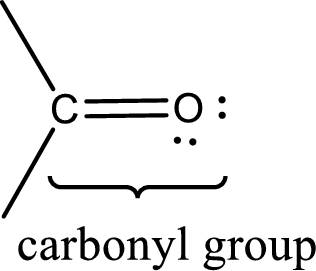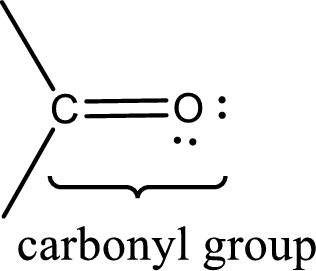
Concept explainers
(a)
Interpretation:
The number of aldehyde groups and ketone groups present in progesterone has to be given.
Concept Introduction:
Carbonyl groups are the one which contain a double bond between carbon and oxygen atom.

The groups that is attached to the carbonyl carbon atom can be either hydrogen or carbon atom. If the attached atoms are hydrogen and a carbon atom means then the compound is an aldehyde and if they are two carbon atoms means then the compound is a ketone.
(b)
Interpretation:
The number of aldehyde groups and ketone groups present in 2-heptanone has to be given.
Concept Introduction:
Carbonyl groups are the one which contain a double bond between carbon and oxygen atom. Aldehydes and ketones possess this carbonyl functional group in it. The structural representation of a carbonyl group can be given as shown below,

The groups that is attached to the carbonyl carbon atom can be either hydrogen or carbon atom. If the attached atoms are hydrogen and a carbon atom means then the compound is an aldehyde and if they are two carbon atoms means then the compound is a ketone.
(c)
Interpretation:
The number of aldehyde groups and ketone groups present in dihydroxyacetone has to be given.
Concept Introduction:
Carbonyl groups are the one which contain a double bond between carbon and oxygen atom. Aldehydes and ketones possess this carbonyl functional group in it. The structural representation of a carbonyl group can be given as shown below,

The groups that is attached to the carbonyl carbon atom can be either hydrogen or carbon atom. If the attached atoms are hydrogen and a carbon atom means then the compound is an aldehyde and if they are two carbon atoms means then the compound is a ketone.
(d)
Interpretation:
The number of aldehyde groups and ketone groups present in cinnamaldehyde has to be given.
Concept Introduction:
Carbonyl groups are the one which contain a double bond between carbon and oxygen atom. Aldehydes and ketones possess this carbonyl functional group in it. The structural representation of a carbonyl group can be given as shown below,

The groups that is attached to the carbonyl carbon atom can be either hydrogen or carbon atom. If the attached atoms are hydrogen and a carbon atom means then the compound is an aldehyde and if they are two carbon atoms means then the compound is a ketone.
Want to see the full answer?
Check out a sample textbook solution
Chapter 15 Solutions
General, Organic, and Biological Chemistry
- 9. How many ketone functional groups are present in the following compound? OH a. 2 b. 3 10. C. 4 d. 5arrow_forward1. Draw the structural formula of the hemiacetal formed from each ơf the following pairs of reactants. a. Acetaldehyde and methanol 0 b. 2-Pentanone and ethyl alcohol С. Butanal and isopropyl alcohol d. Acetone and ethanolarrow_forwardWhat functional groups are present in a carbohydrate molecule? a. Carboxyl and carbonyl groups b. Alcohol and carboxyl groups c. Hydroxyl and carbonyl groups d. Hydroxyl and hydrogen groupsarrow_forward
- Aldehydes and ketones are A. polar molecules capable of forming hydrogen bond among themselves. B. polar molecules incapable of forming any hydrogen bond. O C. polar molecules with large dipole moment. O D. polar molecules that provide hydrogen bond donors.arrow_forwardWhich of the following statements about acetone is/are correct?I. Large amount of acetones are produced in the human body.II. Diabetic patients produces larger amounts of acetone.III. In severe diabetes, odor of acetone can be detected on the person's breath.IV. Acetone is partially a by-product in gasoline treatments designed for engine immiscibility to water.arrow_forward1. Which of the following can be oxidized to produce aldehydes and ketones? A. Alcohols B. Amino Acids C. Carboxylic Acid D. Esterarrow_forward
- a. formaldehyde b. acetone c. benzaldehyde d. acetophenone which among the 4 samples contains the aldehyde group, which among the 4 samples does not contain the aldehyde group? Explainarrow_forward9. There are two ester groups in the drug molecule: A. Pyridoxine hydrochloride B. Cocaine hydrochloride C. Nifedipine D. Morphine hydrochloride E. Drotaverine hydrochloridearrow_forwardFatty acids are distributed throughout the body, via a time-release/transport molecule created by: a. an esterification reaction with glycerol b. a hydrolytic reaction with methylamine c. an alkylation reaction with butanol d. a carboxylation reaction with lactic acid e. an ether formation reaction with ethylene glycolarrow_forward
 Chemistry: The Molecular ScienceChemistryISBN:9781285199047Author:John W. Moore, Conrad L. StanitskiPublisher:Cengage Learning
Chemistry: The Molecular ScienceChemistryISBN:9781285199047Author:John W. Moore, Conrad L. StanitskiPublisher:Cengage Learning
